Interview with author Bob Pakes
'The EPE Catalog'
EIN Interview by Piers Beagley - April 2018
|
Bob Pakes is an early Elvis enthusiast who runs the impressive website 'Elvis Echoes Of The Past'. His first venture into publishing is the incredible 'The EPE Catalog' along with (Elvis Files) Erik Lorentzen.
Over 390 pages 'The EPE Catalog' presents an A-Z guide with over 1,450 images on every weird and wonderful product that was part of the immensely successful 1956 Elvis Presley merchandise train.
The book is an incredible compendium of why teenage America went crazy for Elvis Presley!
EIN has read nothing quite like this before and wanted to know more about the author Bob Pakes and what made him venture into such an crazy fifties teenage world.
We also discussed plenty of other topics along the way including...
- Col Parker good or bad for Elvis' career
- Did Elvis’ creativity die when he went into the army
- What surprises did he discover during his research...
|
 |
1956 was the year that a young man from Memphis, TN, set the world of entertainment ablaze. With his unique voice and good looks, “and a smile that was the most devastating thing since the atom bomb”, Elvis Presley changed popular culture. Forever.
1956 was also the year that American teenagers went wild over the incredible amount of products that exploded onto the scene courtesy of Elvis Presley Enterprises.
Through the combined efforts of Tom Parker and marketing genius Henry Saperstein, Elvis Presley Enterprises turned the art of character merchandising into a booming business.
This A to Z guide contains over 1450 images and detailed information on every weird and wonderful product that was part of the immensely successful 1956 Elvis Presley merchandise train.
Photos from ‘56 and ‘57 show the merchandise ‘in action’. EPE documents, promotional flyers, and articles supply a wealth of background information. While vintage advertisements for EPE products further capture the magic and excitement of the time when Elvis Presley merchandise was sweeping the nation.
Experience why teenage America went crazy for Elvis Presley lipsticks, pencils, belts, key chains, bracelets, bubble rings, bobby socks, boardgames, handkerchiefs, record cases, sneakers, grammophones, dog tag jewelry, scarves, billfolds, dolls, diaries, pins, jumper dresses, necklaces, drinking glasses, medallions, bookends, autograph books, earrings, pillows, bolo ties, plates, paint sets, pennants, pump shoes, jackets, mittens, hats, toy guitars, stuffed hound dogs, jeans, statuettes, t-shirts, pinback buttons, bubble gum cards, photos, pencil cases, binders, poodle skirts, perfumes, magazines, watches, patches, busts, hot plate holders, scrapbooks, photo folios, stationery, motion badges, anklets, pajamas, photo albums, stuffed teddy bears, and sweater holders.
 |
EIN: Thanks for agreeing to talk with us. Fans might know your name through the fascinating ‘Elvis Echoes Of The Past’ website, but when did you first get interested in Elvis?
Bob Pakes: Thank you very much Piers, I'm honored to do this interview. Thanks!
Like so many people from my generation, I became an Elvis fan in 1977. I was 10 years old then. By this time, I was already a fan of Happy Days, and The Fonz had become my first true hero. Happy Days, of course, was set in the 50's and I felt a strong affection for the music, the girls, the clothes, the cars, the drive ins, everything! When Elvis then died, he was all over the place and there simply was no escape. But even before his death, I was already familiar with Elvis' rock 'n' roll music through my parents, especially my dad had a lot of his 45's while my mother only had a few records left because her father had thrown most of them in the fireplace since he thought it was the devil's music. And man, was I captured by the Elvis from the 50's! His voice, his hair, his cat clothes!
Then, a year later, Grease became the word, and even though I did not admit it at that time, I secretly enjoyed the altogether 50's feel of that movie. But the biggest thing for me during my younger days, next to discovering the music of Elvis Presley, was the rockabilly revival of the early 80's, headlined of course by the almighty Stray Cats! During these 3 or 4 teenage years, the foundation of my musical taste was established, and even though I've made regular trips to other styles of music since then, I've always returned to the glorious 50's, mainly because of the music, but also because of the 50's lifestyle altogether.
EIN: Why the fascination with Elvis in the fifties?
Bob Pakes: I don't even know where to start when describing my fascination with Elvis in the 50's. The young Elvis was real. The way he sang, the way he moved, the way he looked. It was all pure, raw emotion. There was nothing fake about this guy. As soon as he opened his mouth, I believed every word. When I first heard Mystery Train, I felt the urge to go down to the train station and buy a ticket. The way he wore his hair, was how my hair should be. His energy and his enthusiasm, and his amazement about his own success. His humbleness, and yet his ability to thoroughly enjoy the ride. The way he was able to handle himself during the hundreds of interviews in those early years. Elvis was a revolutionist, a true rebel. An original. An innovator. He changed pop culture and defined a generation. To me, Elvis in 1956 is pure magic.
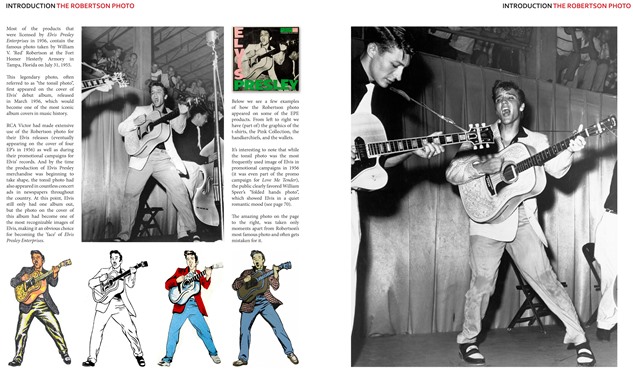 |
EIN: What made you think of putting this incredible book of early Elvis memorabilia together?
Bob Pakes: Ever since I was a young adult, it had been a dream to publish a book. Thirty years down the road this dream had turned into a bucket list item. The subject of vintage EPE merchandise was something I felt very strongly about. It was the kind of book that I, as a 50's fan/collector, would have welcomed very much. But it did not exist, and as time went on, it seemed less likely that a book like this would ever see the light of day since the group of die-hard vintage collectors is only getting smaller. At some point I started to put my lifelong dream of publishing a book and my desire to own a book about vintage Elvis merchandise together, and this eventually resulted in The EPE Catalog.
EIN: Have you published other books, your style of writing is very impressive – especially if it’s not your primary language!
Bob Pakes: Thank you very much! The EPE Catalog is my debut as an author, but in the past 5 years, I've written 140 articles for the Echoes Of The Past website. Next to this, and probably the major reason why I write the way I do, I love to read English literature, especially classic novels. With regard to my writing style, and I've read in a couple of reviews that the text in the book is pleasant and easy to follow, however, this was not done on purpose but merely the result of the limitations of a Dutchman writing a book in the English language, haha!
A big shout out to my friend Judith Verschuuren, a dedicated Elvis fan who also happens to be an English teacher. She was kind enough to proofread the book for me, and without Judith's help the book would now be full of the repeated grammar mistakes that I've been making for over 30 years.
EIN: Erik Lorentzen is the publisher, did you suggest the idea to him or did he contact you?
Bob Pakes: By the time I started looking for a publisher, the book was about 85% finished. I had 4 different publishers in mind, and because of the outstanding quality of his books, Erik Lorentzen was number 1 on my list. I then contacted Erik and explained my idea. Erik was enthusiastic from the start since he felt that the EPE merchandise craze from 1956 was an important part of the Presley legacy that needed to be told. After I had shown Erik 40 of my finished pages, he granted me total creative freedom with regard to the design and lay-out of the book. However, Erik felt that the market would be small for a book about EPE merchandise (an opinion I shared), and he suggested to do a softcover book in order to cut production costs. This would then also mean that the amount of pages would be limited to 300. In my mind, the book was not so much a photo book but rather a reference book. It was the kind of book that auction houses and museums publish, more like a catalog, and I've always visioned this book with a hardcover. After a few more days of discussing our plan, Erik agreed that this book indeed deserved a hardcover. This also meant that there would be no restriction to the amount of pages I would be needing. With these last obstacles out of the way, I was all set to go. This was in June 2017. Erik then determined that the publishing date would be "In time before Christmas".
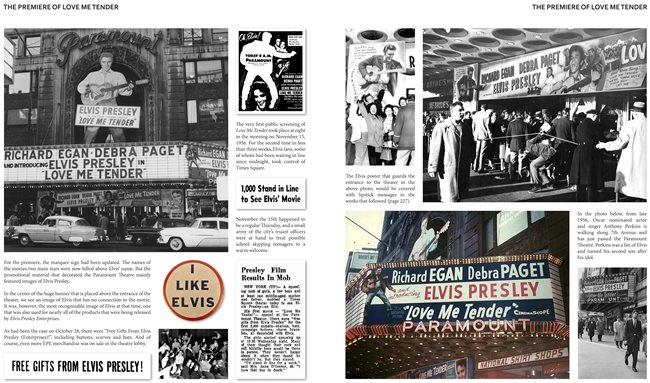 |
EIN: There must have been masses of research, how long did you work on putting the book together?
Bob Pakes: In my head, I have been 'working' on this book for circa 20 years. During this time, it often amazed me that an EPE book never seemed to be an option for any of the Elvis publishers. Not even modern day Elvis Presley Enterprises seemed to realise the importance of a book about this 'forgotten' but very essential part of rock 'n' roll history. Around 5 years ago, I seriously began thinking about how the book would look like if I were to do the job myself. And I actually sat down behind the computer and started fooling around with ideas for a lay-out 3,5 years before I contacted a publisher. This means I've actively worked on this book for 4 years.
During the first 3,5 years, I was very careful not to mention my project to people within the Elvis community that I did not fully trust, so afraid was I that someone would 'borrow' the idea of the book that I was now investing a lot of time in. As of July 2017 (a month after coming to agreement with Erik Lorentzen), I took a break from my regular job, which enabled me to work on the book practically 24/7 for the final 5 months.
For this interview, I checked the external hard disc that includes all of my EPE book files, and there are 8,403 files on this disc. Which is absolutely ridiculous when you think about it, haha! But it goes to show how much information I've collected for this book. Most of these files were only used as reference btw, the finished book 'only' contains close to 1600 images.
I can tell you that it's an almost surreal experience to press the "Sent" button on the screen that transfers the 386 finished pages that you've been working on for 4 years to the publisher. Of course, I always knew this moment would (hopefully) one day come, but with just one simple mouse click, the active part of my dream project came to a close. Seriously man, it took me over a month to kick the daily habit of working on the book, haha!
EIN: The list of experts involved in your project (Chris Giles, Ger Rijff, Alan White, James V. Roy, etc) is pretty impressive, who were the key collectors who helped you?
Bob Pakes: I would not be able to name "the key collectors" since all the people that are mentioned in the book, were fundamental to me, but not all for the same reason. Most of these people indeed actually scanned and photographed their collectibles for the book, others helped with compiling vintage advertisements and articles, some contributed with high resolution images of Elvis, and a few were very important for being a huge inspiration to me. There is also one person in the list of credits that isn't even an Elvis fan/collector, but who designed the Echoes Of The Past website Ger Rijff and I started back in 2013. He did an awesome job by fulfilling each of our wishes, and without Echoes, there would not have been an EPE book today. In short: the book is as complete as it is, thanks to all people involved, and I am extremely grateful to each of the contributors.
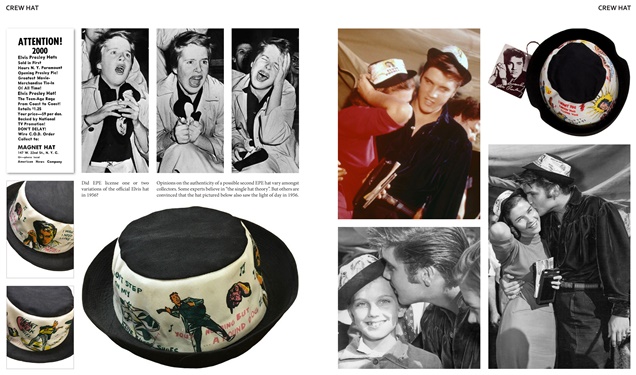 |
Great images of Elvis merchandise "in action"
EIN: I am not a collector of rare Elvis memorabilia as such (it’s the music for me) so I thought that a book about EPE’s early products could be rather dull but your text is incredibly involving. Was putting the book together as exciting as the text imparts?
Bob Pakes: It was an incredible exciting thrill ride! I guess it can best be compared to putting a huge old jigsaw puzzle together of which you don't have the box, so you have no idea what the actual face of the puzzle will look like, and neither do you have any clue as to how many pieces are missing until the puzzle is nearing completion, haha!
I remember, you once told me that you expected that reading a book like this would be like watching paint dry. And I absolutely understood what you - as perhaps a non-collector - were saying. To me, the fact that the Elvis fans that are not so much interested in the subject matter of the book, are also enjoying it, is one of the biggest compliments I could have wished for. Next to bringing together as much info as possible about the 1956 EPE merchandise train, I also wanted the book to feel like a ride with the time machine. I was hoping that not just vintage Elvis memorabilia collectors would be interested in this book, but also 50's enthusiasts in general. Part of the reason why I included so many original newspaper advertisements, was to take the reader back to 1956. This is also why the original retail prices for each entry in the book are given. The same goes for most of the photos in the book which show the merchandise 'in action', I mean, looking at a 60-year old photo of a happy smiling teenager dressed in a cool Elvis t-shirt is far more satisfying than just reading about that t-shirt.
EIN: How much Elvis memorabilia do you personally own?
Bob Pakes: Ever since I started collecting, in 1977, my main objective has always been the music. First of course on vinyl, and in the late 80's I moved to CD's. Yes, I have to admit, I am one of those weird completists who needs to have every worldwide pressing of every RCA/BMG/SONY Elvis CD. Later on, and this started while traveling through the US in the 90's and stumbling upon the most wonderful vintage Elvis items rather by accident, I added 50's memorabilia and movie memorabilia to my want list. This was way before we (collectors) new what kind of 50's merchandise was actually out there because a book like The EPE Catalog did not yet exist. So a collector in those days (especially one who is not from the USA, like me) hardly had any idea about what to look for. Of course, everything changed drastically with the introduction of the internet and nowadays even a recluse living in a remote cabin in the Siberian woods, is able to obtain an "I Hate Elvis" button through eBay.
In sharp contrast to collecting Elvis' music, I never felt the urge to buy each and every piece of vintage merchandise. The same can be said for Elvis movie memorabilia: I only buy what I like. I'm not the kind of guy who displays his rare stuff around the house, and you won't find a special Elvis room at my address either. Apart from some very cool vintage Elvis posters (hanging right next to vintage non-Elvis posters), you won't be able to tell from walking around in my house that such a huge fan is actually living there.
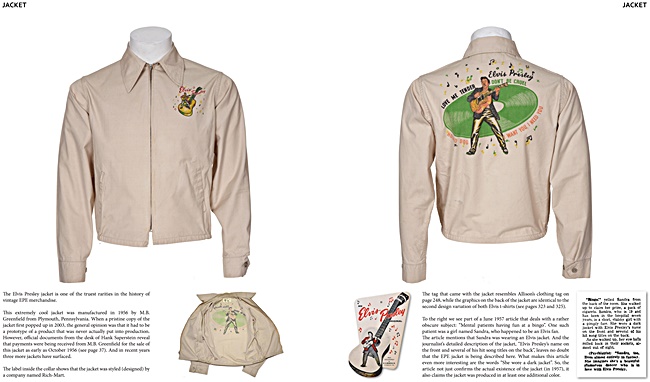 |
EIN: What are your favourite items featured in the book?
Bob Pakes: My absolute favourite is the 1956 jacket, what a blast! Most of the merchandise was aimed at teenage girls, but this jacket could also be worn by boys. Had I been a US teenager in late 1956, I would have definitely walked around in this cool jacket!
From a creative point of view, I would say that the 1957 board game is the most beautiful item ever licensed by EPE. Plenty of thought has gone into developing this game, something that is very rare for an EPE product as we all sadly know. This Elvis Presley Game has become the most valuable board game in the world.
Another vintage product that I like very much is the 4-Speed Victrola, which is one of two Elvis Presley phonographs produced by RCA Victor in November 1956. This item just oozes the 50's, and when listening to an original Elvis 45 on this machine, you simply cannot resist the magical feeling of being transformed back in time.
EIN: What surprises did you discover during your research?
Bob Pakes: The biggest surprise to me was discovering that not Tom Parker but a man by the name of Hank Saperstein had been responsible for the huge Elvis merchandise hype in late 1956. If it hadn't been for the marketing genius of Saperstein, the whole $ 25 million Elvis Presley Industry would never have happened. I would have loved to tell Saperstein's story (and there absolutely was a most interesting story to tell!) on circa 8 to 12 pages in the book, especially since he's pretty much forgotten nowadays and hardly ever gets the credit he deserves. I even managed to get in contact with Saperstein's daughter. But in the end I did not have enough time to include all the things in the book that seemed important to me and I had to leave a few things out, including Hank Saperstein's story. But hey, the book's introduction part is already over 90 pages long, so whose complaining, haha?! And come to think of it, I don't believe that a reader will come to the conclusion that something is missing from the book, it's just that you want to give as much info as possible, knowing that there'll never be a 2nd or revised edition of the book simply because the book as it is, is already very much complete.
 |
Elvis with Hank Saperstein and a selection of possible merchadise
EIN: It is incredible how much everything was driven by Saperstein. What about finding any unknown Elvis products?
Bob Pakes: In fact the already mentioned Elvis jacket was an example of a genuine new discovery. When this white jacket first popped up in auction in 2003, it did not get sold because no one in the collector’s world had even heard of the existence of such a jacket. When EPE's own wardrobe department then examined the jacket, they figured it had to be a prototype of an item that was never actually put into production. And this is also how a copy of the jacket was sold on Graceland's own auction site a few years ago. But through an official document signed by Hank Saperstein in October 1956, I discovered that the jacket had in fact been manufactured and sold commercially in late 1956. I also found a 1957 newspaper article in which a girl was described who was clearly wearing this Elvis jacket, however, the color of her jacket wasn't white but black. All this new info meant that the jacket was not just a prototype but that it had actually been produced and sold commercially in at least two different colors as early as October 1956. Discovering new facts like these, even though they may sound very insignificant to non-collectors, is what made the research process so much more interesting. And btw, while compiling the book, I learned that this incredibly rare jacket was in the hands of no less than 4 different Elvis collectors (at least!), which just blew me away.
Another example of one of the many minor, but to me very interesting, discoveries, involves an EPE product that is commonly referred to as "a coaster or ash tray". I found a document from late 1956, in which 3 closely related EPE items (the drinking glass, the 12" glass plate, and what turned out to be the porcelain bobby pin tray) were being described. This was how I discovered that the item that had been referred to in all collectors books up until that point as either a coaster or an ash tray, was actually a bobby pin tray. I never understood why this bowl shaped item could be seen as a coaster in the first place, and I just knew that Elvis would never have agreed to the production of an ash tray. Why collectors (and also eBay sellers) have been wrongly referring to this pin tray, is the result of the very first Elvis collectibles book (from 1983) referring to this item as such, and the wrong info was then copied into all subsequent collectors books.
 |
EIN: The prices are all quoted as the original cost. One dollar in 1956 seems “cheap” yet it converts to close to $ 10 in today’s currency. So it’s a shock that the Elvis Phonograph cost $ 40 = $ 400, that’s a big deal compared to today’s ipod era?
Bob Pakes: The two Elvis Presley phonographs were indeed very pricey. In part because of their hefty price tag, they did not sell well. It was, however, possible to buy a phonograph with weekly payments of $ 1 or $ 1,25, but a teenager needed a parent's signature for such a contract, and parents were not too keen on Elvis. Besides, the kids rather spend $ 40 on 20 or 30 smaller pieces of Elvis merchandise than on 1 expensive item. Btw, it's interesting to note that the bonus EP's that came with the Elvis record players, are now among the rarest Elvis records in the world.
Most EPE products retailed at $ 1, like the many different pieces of jewelry, the statuette, the series of dog tags, the plastic and leather belts, the perfume, the bolo ties, and the lipsticks. The cheapest item (not counting the truckload of pinback buttons) was the Elvis handkerchief, selling for 39¢, followed by the 50¢ Elvis Answers Back! magazine. Apart from the phonographs, the most expensive EPE item was the 6-string toy guitar, which retailed at $ 12.
EIN: One thing not covered in the book is how much the rare pieces go for at auctions nowadays. Did you consider including this or is it all too variable.
Bob Pakes: At first I did not consider including a price list, because, like you suggest, the value of vintage items is way too variable. But while being in contact with fellow collectors during the making of the book, I was advised by many of them to include such a price list. But the way I look at it, the buyers of these collectibles, so the people that actually spend top dollar on vintage EPE merchandise, know exactly what the items go for nowadays. And someone who's not an expert, will not spend hundreds, let alone thousands, of dollars on these kind of items anyway. So in the end, I decided to leave it out. The only reason for me to include such a list, would have been the shock value that these kind of lists usually have (as a result of the high values). And if I had included a price list, it would only have been 1 double-page in the book, and the estimates given, would have been the values that are mentioned in Presleyana.
EIN: One thing that amazed me was you managing to track down some astounding pieces, such as cardboard packing boxes or cotton clothing which (60 years later) should all have fallen apart or been thrown away. How hard was it to find good quality pieces?
Bob Pakes: Believe it or not, the hardest part was not to find the actually pieces, but rather obtaining high resolution images of these collectibles. When compiling a book like this, you primarily need images of the highest quality and not so much the actual products. But I found out that taking a good quality photo, or even a 'simple' scan of a paper item, can be the hardest thing to do for many people, including myself!
The standard I had in mind for presenting the EPE products in this book, was the way that items are usually displayed in catalogues and on websites of renowned auction houses. Also museum catalogues tend to use this style. This meant that all EPE items needed to be photographed in high resolution and presented against a pure white background. However, in my enthusiasm, I underestimated how difficult it was for non-professional photographers, who of course don't have the same equipment and possibilities that auction houses and museums have, to photograph a certain item without optical distortions, unwanted shadows, bad angles, etc. As an example, an item like the crew hat is easy to photograph. But the 12" glass plate proved to be a tough little bastard. This plate is of course round, and taking a full frontal picture of it without distorting the perfect round circle, while keeping in mind that you do not want to see the reflection of the flash in the glass in your image, is much tougher than you first think it is.
The contributors of the merchandise photos, were all pleased and proud to see their specific item(s) turn up on the pages of the EPE book. But in some cases, I had to leave their photos out in favor of an image of the same product that had appeared on a professional auction website, because, in the end, the quality of the photo always determined which image I would use. My respect goes out to the helpful and very patient collectors who must have gone mad when I kept on pushing them to give a certain photo another try. But I can promise you that no collectors were hurt (or ended up in the madhouse) during the making of this book.
 |
EIN: Personally I have always wanted that well-known James Brown doll; here the shock is how bad the Elvis doll actually looked – apart from the hair, nothing like Elvis!
Bob Pakes: Haha.. yes, ain't it incredible?! Of course, the fact that the doll was meant to resemble Clint Reno (Elvis' character in Love Me Tender) and not Elvis the rock 'n' roll singer, also didn't help very much. The design of this doll is probably the best example of how commercialized Elvis Presley as a product had become in a very short space of time. After all, in a matter of just a few months, the producers of Elvis merchandise didn't even seem to care anymore how the product actually looked, they calculated that it would sell anyway, as long as Elvis' name was attached to it. And what may come as a surprise to many people: not a single piece of EPE merchandise went into production without a personal okay from Elvis.
Interestingly, a few years ago, just the head of this doll went for $800 on eBay. Imagine that you are the collector who just bought that head: how would you break the news to your wife? "Look what I bought for a mere 800 bucks, dear!", haha! But no matter how unlike-Elvis this doll is, it is also one of the rarest and most sought after vintage EPE items. A complete doll in a good shape will set you back around $ 2000. But hold on to your seat: a few years ago, a doll that still included its original box, sold for over $ 6000.
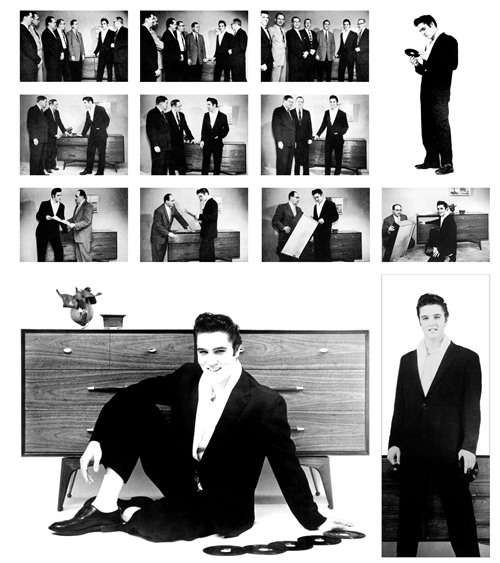 |
EIN: How strange that Elvis did that photo shoot for Hungerford Furniture yet there didn’t seem to be anything “Elvis-Style” about the furniture at all, i.e. no logos used. Whose idea would that have been?
Bob Pakes: The whole idea came from Hungerford. Apart from how impossible the combination of a rocking and rolling Elvis Presley and stiff solid mahogany furniture actually was, this ridiculous business plan also tells us how huge Elvis was by late 1956. He was so big, that just the mention of his name kept the cash registers ringing, so I guess you can hardly blame Hungerford for jumping on the extremely successful bandwagon of their hometown's most famous citizen in order to be able to advertise a special section of their furniture as "Endorsed by Elvis Presley". But their campaign was a huge failure and sort of erased from history. Until the publication of the Hungerford related newspaper articles and advertisements in the EPE book (that prove the actual production and existence of Elvis Presley furniture in early 1957), the general belief within the Elvis community had always been that Hungerford had abandoned their Elvis campaign right after the photo shoot had taken place. But as we now know, this is not true: Elvis Presley furniture is out there.
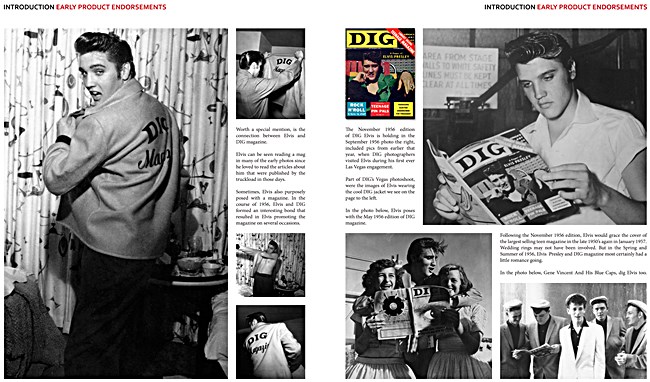 |
EIN: In the book you also make a point about Elvis obviously endorsing other products.
Bob Pakes: That’s right. Another myth that gets debunked in the book, is that Elvis singing the jingle of Southern Maid Donuts during his early Hayride days in 1954, was the only occasion during which Elvis endorsed a commercial product. This is false on many different levels. The false 'fact' was brought into the world by Southern Maid (obviously), and as is often the case with false 'historical facts', the info then got copied from one book to another and before you knew it, this false info was seen as fact. The truth is that performers on the Hayride had an obligation to promote the sponsor of the show, Southern Maid Donuts, during their performance, this was merely 'part of the deal' and not a standalone endorsement. The recording of Elvis singing the jingle has not yet surfaced and appears to be in the hands of a private collector, but we can get a taste of how this kind of "product endorsement" went about by listening to a similar Hayride recording of Johnny Cash.
On the subject of Elvis apparently only having endorsed one commercial product, during 1956 Elvis actively promoted DIG magazine on several occasions by posing with different editions of this magazine and even putting on a DIG jacket in front of DIG's photographers. These images can all be found in the book. Also in the book is a newspaper article from 1956 in which Elvis poses with two AMI executives in front of AMI's latest jukebox model. And what about the magazine advertisements of Elvis riding a Honda in the 60's? If certain Elvis historians still tend to see the Southern Maid situation as "the only time Elvis endorsed a commercial product", then how do they qualify Elvis' obvious connections to DIG, AMI, and Honda?
EIN: What’s the most valuable piece of memorabilia featured in the book?
Bob Pakes: I put together a list of 15 rare items, just to give you an idea of the value of certain EPE products. The prices mentioned, were the actual selling prices of these specific pieces of Elvis merchandise:
Elvis 1956 cake decoration $ 1150
Elvis 1956 toy guitar (complete set) $ 1230
Elvis 1957 board game (nearly complete) $ 1500
Elvis 1956 black poodle skirt (without tag) $ 1625
Elvis 1956 phonograph (complete set) $ 1625
Elvis 1957 doll (without box) $ 2000
Elvis 1956 4 flasher buttons on display card $ 2050
Elvis 1956 white jacket (without tag) $ 2375
Elvis 1956 12 rings on display card $ 2380
Elvis 1956 gray jumper dress (without tag) $ 2500
Elvis 1956 12 rings on display card $ 2750
Elvis 1956 white sneakers (with box) $ 3750
Elvis 1956 black sneakers (with box) $ 3900
Elvis 1957 doll (with box) $ 6250
Elvis 1956 gray jumper dress (with tag) $ 8950
Next to the items that have sold in auction and for which a price value can be given, we also have a handful of vintage EPE products that have not been seen since the heyday of Elvis mania, like the ladies gloves from 1956 and the Elvis jeans from the same year. The value of these items can therefore not be determined. We do, however, have photographical evidence of the existence of these mega rare Elvis products.
An item that is generally regarded as the holy grail of vintage EPE merchandise, is the 1956 Elvis wrist watch. This watch has never surfaced, and only 1 clear photo of the Elvis watch exists. I reckon that should this item ever appear in auction, it will set a new record for the most valuable vintage EPE product ever.
And then there are the EPE products that have only surfaced in one or two color variations even though they were manufactured in a wider variety of colors, like the 1956 skimmer pumps. These shoes have only surfaced in black and red leather, but they were available in 6 different colors, and a suede variation was also manufactured. Should any of the less common variations ever appear in auction, you can bet the price will go skyhigh.
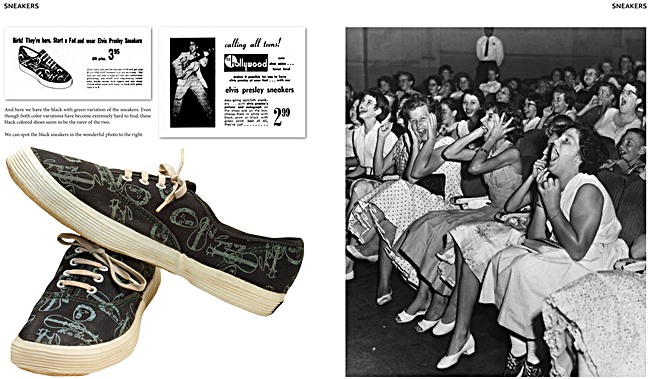 |
EIN: WOW, buying a Elvis jumper dress that you could never wear for near $9000 is incredible! Does your interest in collectibles continue into the Elvis sixties and seventies?
Bob Pakes: I do like some of the collectibles from the 60's, but this is restricted to paper items only (not counting the handful of EPE item that were produced until 1962). But of course, there were hardly any collectibles available to Elvis fans in the 60's. What these fans had in abundance, were movies, plenty of movies! And the posters/lobby cards/stills/etc. that were manufactured around the world in the 60's in order to promote these movies, are now very collectible and most certainly have my interest.
Even though I'm a 50's addict, I like most of Elvis' music from the 70's. But I was never into collecting menus and other Vegas stuff, or 70's memorabilia (Boxcar) in general. And unlike most Elvis memorabilia collectors, I also never had any interest in owning any of Elvis' personal belongings.
EIN: So what's your thought on the comment that 'Elvis’ real creativity died when he went into the army'?
Bob Pakes: Most certainly not. And you are talking to an 'Elvis army fan' here, haha! I personally believe that his time in Bad Nauheim must actually have been a most welcome break for Elvis from a human being's point of view following the crazy rollercoaster ride he had been on since 1955. And let's not forget that Elvis was still only 23 years old when he went into the army. Trying to realise what this young guy had gone through in the years prior to serving Uncle Sam, is simply impossible. I believe that his 17 months in Germany, was the last phase in his life during which Elvis could just be Elvis, before he got himself locked away in that cage with golden bars called Graceland. When you take a look at the thousands of candids that exist from the Bad Nauheim period, most of which were taken right in front of his house in the Goethestrasse, Elvis always looks relaxed, talking to his fans, hanging out with the locals. He could often be seen reading the newspaper on his doorstep or playing football with some friends on a nearby field. And all this time there were never any bodyguards. Elvis was THAT approachable when he lived in Germany.
I urge any fan interested in the real Elvis, to go and visit Bad Nauheim. It's only a very small place, and you can feel the magic by literally walking in Elvis' footsteps while going through this awesome little town.
EIN: Of course I was teasing you, being the fifties fan that you are. But Parker really took control while Elvis was in the army?
Bob Pakes: Sure, we can't deny that Parker's stranglehold on Elvis had a huge effect on the way that Elvis was able to express himself as an artist. Especially during the 60's Elvis was extremely limited, like a tied up beautiful butterfly. He was hardly ever challenged creatively during the movie years. But even during the most horrible and wasted phase of his career (up until that point anyway), Elvis created songs that I regard as true works of art. Take a song like Tomorrow Is A Long Time, I firmly believe there'll never be an artist able to match what Elvis did here. And it only took him 2 takes to create this masterpiece.
So, no, I don't think Elvis' creativity died when he went into the army. And even though I very much regret the years lost in Hollywood, we would never have had the most wonderful comeback an artist has ever achieved when Elvis reclaimed his throne at NBC. And without the dreadful movie years, there would not have been the most glorious event since Elvis' recording sessions at Sun, when an armed to the teeth Elvis Presley entered American Sound Studios in January 1969, more determined and more powerful than ever before.
EIN: What do you think would have happened had Elvis not got drafted? Is it possible he could have kept the power of rock ’n’ roll burning longer, helped halt that disappointing slide into inconsequential fluffy 60’s pop and altered the impact of The Beatles?
Bob Pakes: That's a lot of questions, haha! No, I don't think the rock 'n' roll phase would have lasted much longer had Elvis not been drafted. These musical phases come and go, it's always been that way. Hardly ever did a musical phase last longer than a few years, and this is probably because the group of fans that are usually responsible for creating such a phase, the American teenagers, have outgrown the craze they helped create merely 2 or 3 years later because, by this time, they have reached young adulthood and are ready to move on in life.
In the minds of many people, the reason that the rock 'n roll era ended, is that Elvis went into the army, Buddy Holly died, Little Richard found God, Jerry Lee Lewis married his young cousin, Eddie Cochran died, etc. But I think it was more a case of the latest generation of teens doing what teens always do: rebel against establishment. Music has always been a very important tool for teenagers to express themselves, and by circa 1959, rock 'n' roll had become part of the very establishment it once rebelled against. So the new generation of 16 and 17 year olds did exactly the same thing as their age group had done 2 or 3 years earlier: they moved on to something new and exciting.
Before the British Invasion, but after the phase of the singing/acting pin up models, there was the twist. Nowadays pretty much forgotten, but the twist was incredibly huge in those days. So huge in fact, that the mastermind behind the whole EPE operation, Hank Saperstein, figured he could do exactly the same thing with Chubby Checker in 1961 as he had done with Elvis Presley in 1956. In the end, the twist craze lasted even shorter than the rock 'n' roll hype and Saperstein cried a million tears. But this just goes to show that musical phases indeed come and go, and they can only be manipulated so much by managers and smart businessmen, because in the end it's always the public (the teens!) that decides how big the latest craze will be and how long it will last.
With regard to the British Invasion, headlined by The Beatles, in 1964, the Rolling Stones' first single in the USA was a cover of Buddy Holly's Not Fade Away. There simply is no denying that the ground-breaking rock 'n' rollers from the 50's, have influenced the new wave of British teen idols of the 60's. And let's not forget, the 60's idols that were sawing the legs from under Elvis' throne, were rebellious teenagers themselves when Elvis took the world by storm with his "new distinctive style", and they most certainly learned from the best!
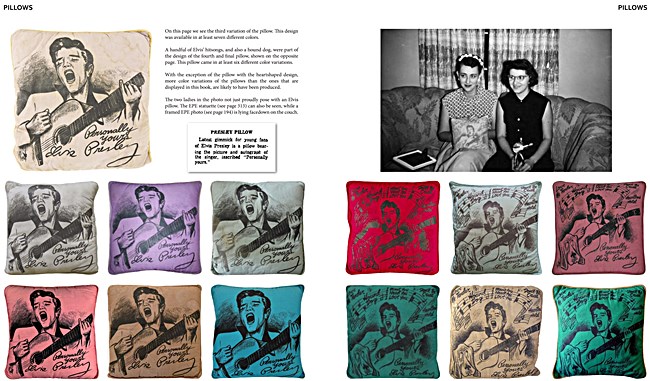 |
EIN: What caused the incredibly fast collapse of EPE’s marketing, was it a simple case of Elvis the person no longer touring and being reachable for his teenage fans?
Bob Pakes: The collapse had nothing to do with Elvis no longer touring. In fact, the abrupt end of Elvis merchandise mania, took place around 7 or 8 months before the touring ended. And even though Hank Saperstein did the best he could to drain the very last dollar out of Elvis' loyal followers in early 1957 (by this time even Tom Parker had already moved on to exploring new means of making money), the fans simply had enough. Fads are contrived by company execs, but it's the public that determines when enough is enough. Fads, as a cultural phenomena, usually only have a short, although very intensive, life span. The EPE hype only needed a few weeks to take off before it devoured teenage America, but it took even less time to come to a crash landing. This is how fads work.
EIN: So what took over as the next major phase for American teenagers?
Bob Pakes: As Jerry Lee Lewis once put it, after the rock 'n' roll era had ended (and this phase actually only lasted from about 1956 to 1959 tops), "the Bobby's took over". It was the phase of the pretty boys, the pin up idols that invaded the charts and the movie screens. One or two were incredibly good and made it to the top on their own strength, like the multi-talented Bobby Darin. But most others were created by clever managers and producers at the conference table. You only have to take a quick look at someone like Fabian: he sure was a handsome guy, but he seriously lacked talent. Yet, he was one of the most popular stars during the post rock 'n' roll era. How times had changed!
EIN: Colonel Parker was obviously a sensational product marketer, but looking at Elvis' career overall - good or bad?
Bob Pakes: The question implies that Parker was the man behind the success of EPE in 1956. But this is not entirely true. It was in fact Hank Saperstein, the true marketing genius, who made EPE the success that it was. All Parker had done, and we have to give him credit for that, was putting the right man in the right place. Saperstein was that right man. As soon as his contract with Parker was signed, Saperstein repeated what he had done earlier when he successfully marketed The Lone Ranger and Lassie. Saperstein was not just responsible for licensing each and every one of the 80 Elvis products, he was also in charge of distribution, he took care of all promotions, and he managed the huge Elvis Presley Fan Club, which he turned into the perfect tool for reaching the millions of Elvis fans across the country and sell them his Elvis merchandise.
as for 'Parker: good or bad for Elvis' career?' Not just bad, but terrible. Before I started doing research for this book, I hated his character. By the time the book was finished, I totally despised the man. Some people say that Parker was "clever" or even "a genius". I think he was a manipulative narcissist whose only mission in life was to help himself. In response to the often heard statement "Parker did a lot of good things for Elvis", I would say that even a pathological liar sometimes tells the truth. Parker did Elvis way more bad than good, and I have zero respect for him as a human being.
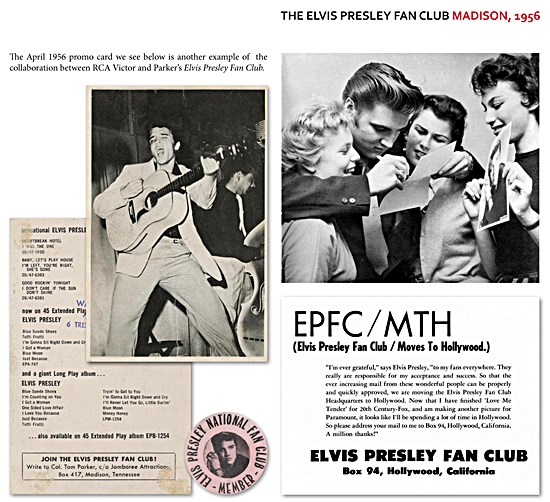 |
EIN: Wow! That’s a stronger reaction than I get from most Elvis fans!
Bob Pakes: My own little protest against Parker's style of managing Elvis Presley, is that nowhere in the book do I refer to him by his honorary title. Only when quoting a person talking about Parker as "the Colonel", I naturally had to include this title, but in my own text I only refer to him by his 'real' name (and even this name was something he had invented for himself). Parker used his title to place himself above the rest. It's purely psychological, and most people don't even realize that when referring to the person you are communicating with as "the Colonel" (or by any other rank or status, like "the Doc"), you actually place yourself below that person. Try to imagine how Parker's business partners would have approached him in a conversation if he had called himself "Chief Fluffy Bunny". Would it have made any difference? You bet! By calling himself "the Colonel" he dominated the conversation with his business partners. And this is what Elvis was to him: business. Nothing more. He didn't have the slightest interest in Elvis' ambitions as an artist. And have you ever heard Elvis refer to his manager as Tom? No, never. But Parker on the other hand always referred to his golden goose by his first name. The situation with the phoney Colonel rank is just one of many examples of how Parker shamelessly manipulated his business partners for personal gain, and this included Elvis Presley.
If only Elvis had listened to what Deke Rivers had to say about managers like Parker:
"That's how you're selling me, isn't it?
A monkey in the zoo, ain't that what you want?
It's not my future you're interested in, it's yours.
It's what I can do to help you."
EIN: What’s your favourite Elvis song and album, and what other music is on high rotation for you?
Bob Pakes: Well, since I'm a 50's Elvis fan, it might come as a surprise that my favourite Elvis song is Gentle On My Mind (the overdub version with the harmonica) from 1969. This version of the song is so hauntingly beautiful and the unbridled emotion in Elvis' voice gets me everytime. It wouldn't say this is Elvis' best recording, but it's definitely the song that I've listened to the most.
The album that I would rank as my personal favourite Elvis LP, is Golden Records, Volume 2. And once again I can't say it's his best, but for sure it's the one with the most plays. The album that I would call his best has to be Elvis Presley from 1956.
Next to enjoying the Elvis Presley song book, I'm very much into rockabilly, rock 'n' roll, singer/songwriters and rock. Buddy Holly, Eddie Cochran, Bobby Darin, Johnny Cash, Kris Kristofferson, Bruce Springsteen, John Mellencamp, The Gaslight Anthem, The Pogues, Steve Earle, The Brandos, The Airborne Toxic Event, Kings Of Leon, Nathaniel Rateliff, JD McPherson, to name but a few.
EIN: I was pleased to see ETM&HM magazine recently reviewing your book as, “a beautiful and engaging book with some hidden surprises”. How has the reception been elsewhere?
Bob Pakes: Thanks. Yes, I was also quite happy with the review in ETM&HM. Though I must admit that I don't understand why a person who states in the review that he has no interest "at all" in the subject matter of the book, gets to review a specialized book like The EPE Catalog. I mean, this book is for the happy few and in my belief a book like this should be reviewed by an EPE collector or a collectables expert. Sure, any sane person can comment on the lay-out of a book, or on the quality of the paper, or on the style of writing. But it takes an expert to actually comment on the subject matter of any specialized book. I'm not complaining, especially not since ETM&HM's review was positive, but the reviewer was clearly not capable of diving into the actual subject matter.
I'm very pleased that all reviews of the book, so far, in fan club magazines and on websites, have been very positive. When I received the Belgian fan club mag, I could hardly believe my eyes that no less than 4 pages were dedicated to my book - even though also this reviewer had nothing to say about what the book is really about and he filled the 4 pages with general and well known talk about Elvis Presley Enterprises. My biggest surprise, however, came with the review that was in the magazine of a German Elvis fan club: this reviewer had certainly done his homework and over the course of 7 pages he carefully reviewed the book, chapter by chapter, going into detail about every important aspect. German thoroughness! To me, this review was the most accurate of all reviews.
 |
EIN: It’s been great to find out so much about the book and we’ll make sure that fans keep on checking out your great website.
Bob Pakes: Thank you so very much Piers, I enjoyed the questions a lot and I hope that my answers have supplied interesting information about the time when EPE merchandise was cool!
As of this year (2018), Echoes Of The Past is no longer a one man adventure. Elvis scholar Robert van Beek has joined me at the helm of the website, and our goal is to publish a new article every 2 weeks. The style of the website will definitely not change, just the frequency by which new and unique (mostly 50's related) articles will be presented.
If there are 50's enthusiasts out there who would like to put an in-depth article together (not just Elvis, but all things 50's!) and have it presented on Echoes, just get in touch with me or my partner in crime through the website!
Click here direct to WWW.ELVISECHOESOFTHEPAST.COM
EIN notes that 'The EPE Catalog' has already sold out at the publisher, but it can still be obtained through the usual channels, including: the elvis shop london
Also please check with YOUR local Elvis Shop just in case they may have a better deal with local postage.
Interview by Piers Beagley.
-Copyright EIN April 2018
EIN Website content © Copyright the Elvis Information Network.
Click here to comment on this interview
Coming soon - EIN's review of 'The EPE Catalog'
Alan Hanson 'Elvis: The Movies' Interview: Respected Elvis author Alan Hanson, along with Erik Lorentzen, has just published 'Elvis - The Movies', 432 pages examining all of Elvis' movies and including some sensational photos.
Elvis Presley's dream was to become a movie star, and the dream started well for him. His acting ability developed steadily throughout his first four movies. But, alas, it was the music which first gave him access to Hollywood, that proved the undoing of his acting career. The inevitable result was a long series of films with weak plots in which only the music mattered.
Author Alan Hanson chronicles Elvis' cinematic career, combined with hundreds of stunning photos from Erik Lorentzen's exclusive collection. But what does this book offer that other Elvis Movie books don't?
EIN's Piers Beagley interviewed author Alan Hanson to find out more..
(Interviews, Source;ElvisInformationNetwork) |
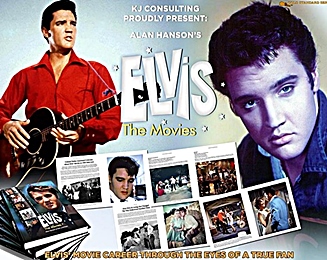 |
EIN Website content © Copyright the Elvis Information Network.
Elvis Presley, Elvis and Graceland are trademarks of Elvis Presley Enterprises.
The Elvis Information Network has been running since 1986 and is an EPE officially recognised Elvis fan club.
|
|




















